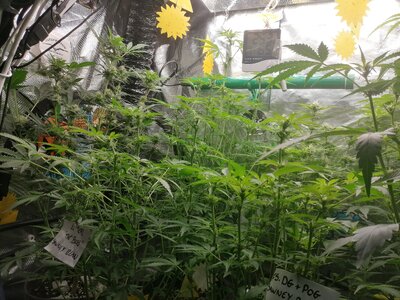I noticed that you have Crystal things in your pots, I guess thats an experiment?
Maybe this is of interest to you.
anyway, I was reading an article on the web,
https://www.sciencenews.org/article/cold-plasma-agriculture-sustainable-farms-fertilizer
which I found rather interesting and then thought about all the sciencey types on this site. and remembered the stones/crystals
The included copy paste is what i found most instantly interesting.
I will not be growing again for at least a 9 months so have no chance to test the article.I also dumped my sons plasma lamp only a couple of months ago in a clearout, thats how it goes.
Experiments led by biochemist Alexander Volkov of Oakwood University in Huntsville, Ala., offer another example of the kind of research going on in plasma agriculture. Volkov studies the ways in which plants and electromagnetism interact.
Recently, Volkov set out to study how plasma would affect 20 seeds of dragon’s-tongue, a cultivar of the bush bean
Phaseolus vulgaris. The experiment was low-tech. He and colleagues balanced the seeds on a plasma ball for one minute each, then incubated the seeds in water for seven hours. Two days later, the scientists found that in plasma-treated seeds, the radicle — the little protrusion of root that makes a seed a seedling — measured 2.7 centimeters, compared with 1.8 centimeters in untreated seeds,
a gain of 50 percent. The team reported the results in
Functional Plant Biology in February 2021.
Roots emerge
Biochemist Alexander Volkov and colleagues exposed bush bean seeds to plasma jets, then immersed the seeds in water for a day. Two days later, plasma-treated seeds showed larger radicles, or starter roots. The least growth occurred in untreated seeds. The others received plasma for 30 seconds, one minute, five minutes and 15 minutes (shown below). Using a plasma globe, he got less striking results.
No treatment
5 minutes
30 seconds
15 minutes
1 minute
All images: A.G. Volkov
et al/
Plasma Medicine 2020
Less than a centimeter of extra growth may seem modest, but Volkov was encouraged. The benefit couldn’t have come from the reactive species of nitrogen and oxygen because they can’t exit the glass sphere, but somehow, the treated seeds seemed to take up more water to grow faster.
To investigate that idea, he and colleagues studied the seeds using an atomic force microscope and magnetic resonance imaging, which reveals how tissues take up water. At the micrometer-level view of the atomic force microscope, Volkov saw that exposure had roughed up the surface of the seeds. The images looked like carved mountain ranges. Those ridges gave the water more surface area to glom on to, and more openings through which to soak the inside of the seeds, he hypothesized. MRI images of treated beans showed larger swaths of white — indicating more water inside — than untreated beans.
“When we use the plasma balls or lamps, the water can penetrate easily through the pores and accelerate germination,” he says.






